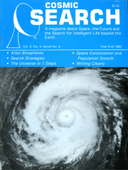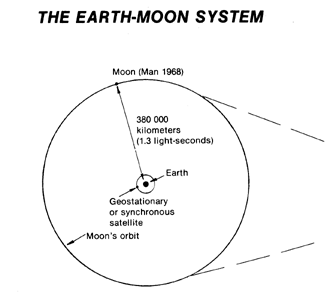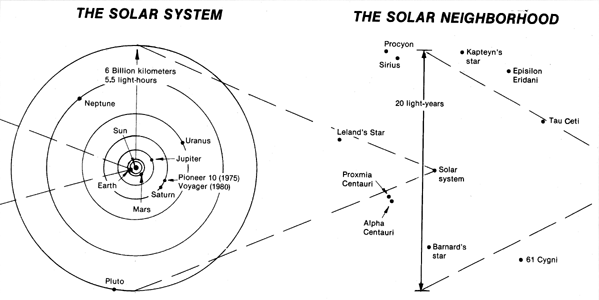![[NAAPO Logo]](../../Images/NAAPOsm.jpg) North American AstroPhysical Observatory (NAAPO)
|
|
ABCs of Space
THE UNIVERSE IN SEVEN STEPS By: John Kraus
The topic for this issue is taken from a few pages of my new book OUR COSMIC UNIVERSE (Cygnus-Quasar Books).* (* Copyright © 1980 John D. Kraus.)
We live in a vast and mysterious universe. We are gradually learning something of its enormous size and of the rich variety of objects it contains. By way of introduction let us take a brief excursion across it.
The earth is a spinning sphere or planet which, with eight other planets, revolves around a star we call the sun. Beyond the sun and its planets are other stars, the nearest of which is more than 4 light-years away. That is, it is so far it takes light, traveling 300,000 kilometers per second, more
than 4 years to travel the distance. The sun and 100 billion other stars constitute our galaxy, a huge flat, disc-like aggregation of stars turning like a great wheel in space. Beyond our galaxy are 100 billion other galaxies which fill our universe.
With this brief overview in mind let us go back and take the trip in a more leisurely fashion, this time in seven steps:
Step 1. The Earth and Its Rings. The rings of Saturn are its best known feature. From close-ups radioed back from Voyager 1, its three principal ring zones appear to consist of many narrower ones, perhaps hundreds of them, looking much like the grooves on a phonograph record. Not only Saturn, but Jupiter and Uranus have rings.
The earth also has rings, at least four of them: two Van Allen rings (or belts), a Clarke ring (or orbit) and extending farthest out, an auroral ring. These rings were described in ABCs of Space in the last issue of COSMIC SEARCH (Summer 1980, Serial number 7.).
In this issue we will continue the trip through Steps 2, 3 and 4 and then complete our journey across the universe via Steps 5, 6 and 7 in the next issue.
Step 2. The Earth-Moon System. Light or radio waves can travel the distance to the moon in about one second. This is the distance reached by manned exploration.
Closer to the earth (at about 36,000 kilometers) are the man-made synchronous satellites travelling around the earth once per day, staying fixed or synchronized above a point on the earth's equator as explained in Step 1.
Step 3. The Solar System. The sun, its nine major planets and 1000s of minor planets or asteroids constitute the solar system. The sun is a nuclear-powered star about one and one-half million kilometers in diameter. It is 6 billion kilometers from the sun to the outermost planet, Pluto. Light or other electromagnetic waves travel this distance in 51/2 hours. The earth-moon system is relatively close to the sun at a distance light traverses in 8 minutes.
Unmanned probes have penetrated to the orbit of Saturn or one-third of the way to Pluto. The earth-moon system of Step 2 must be reduced by a factor of 10,000 to correspond to the scale of the solar system (Step 3).
The dots showing the sun, earth and other planets are relatively too large. To represent their proper sizes they should be at least 100 times smaller in diameter.
Step 4. The Solar Neighborhood. The sun and some of the closer stars form the solar neighborhood. There are a dozen stars closer than about 10 light-years, the nearest being about 4 light-years; however, with the exception of Sirius, Alpha Centauri and Procyon, they are too faint to be seen with the unaided eye.
The solar system must be reduced by a factor of 17,000 from the Step 3 diagram to be the correct size in the solar neighborhood diagram. The dot for the solar system (diameter equal to Pluto's orbit) should be at least 1000 times smaller, while the star dots are a million times too big.
|


